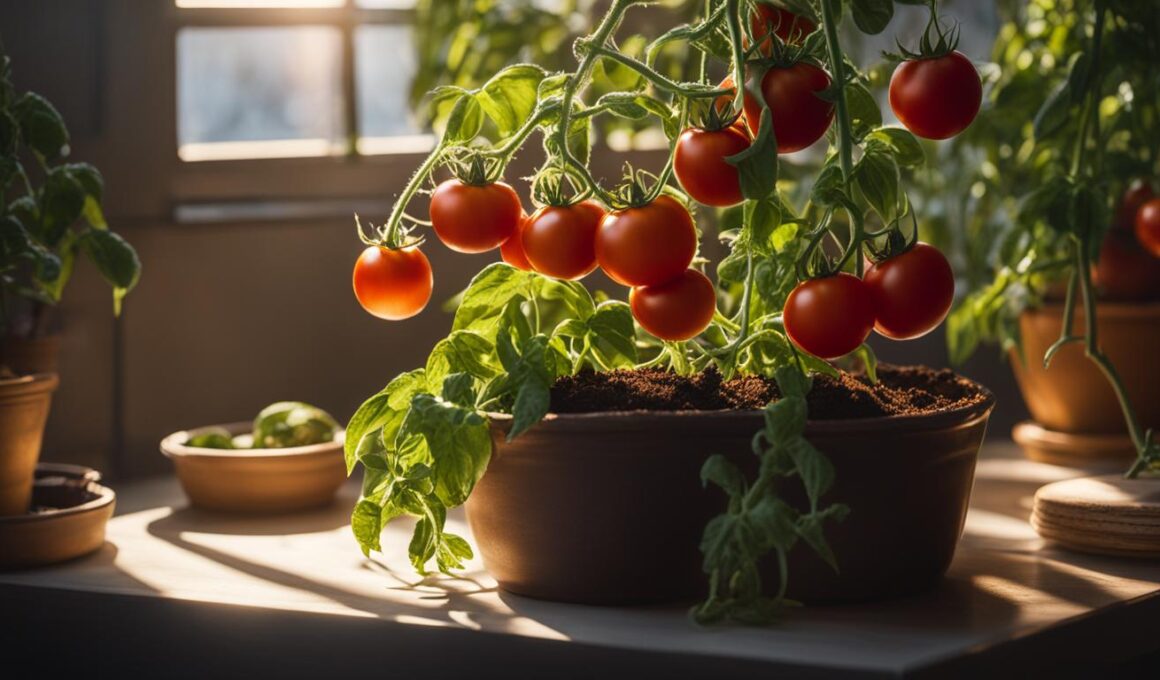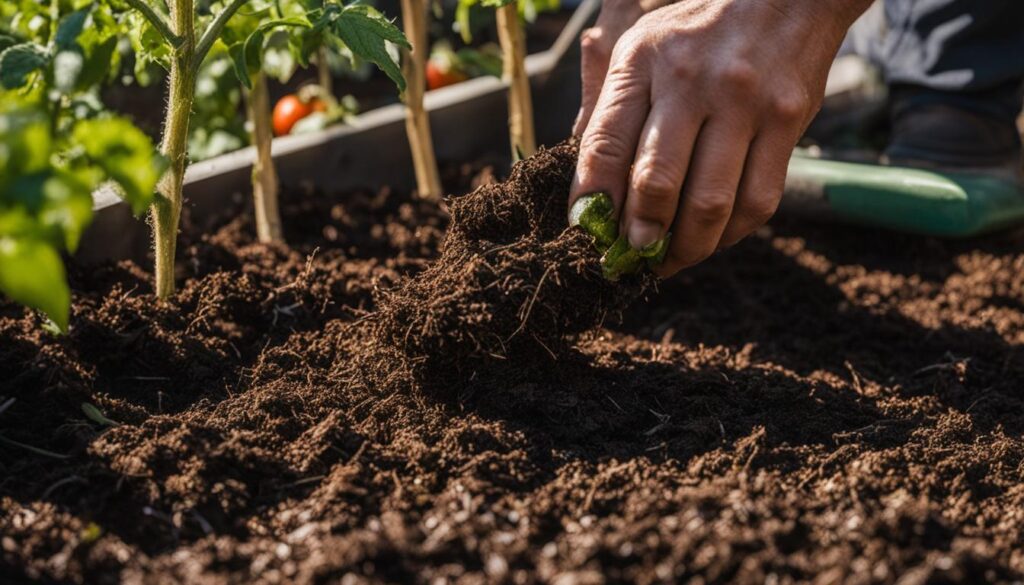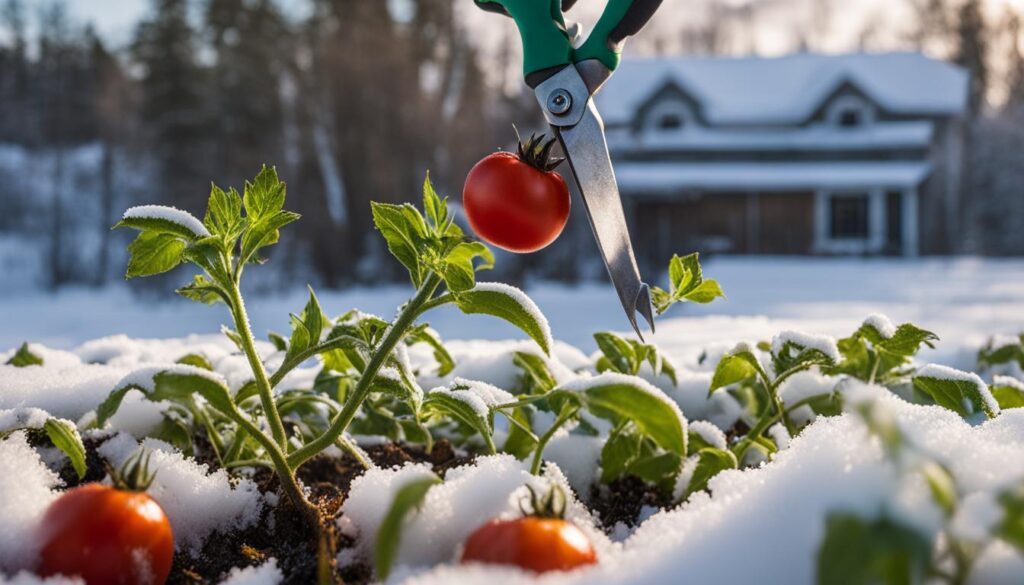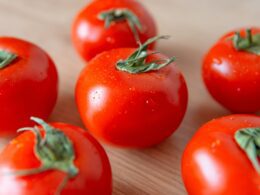Growing tomatoes in winter can be a challenge, but with the right tips and techniques, you can successfully nurture bountiful tomatoes even in the colder months. In this comprehensive guide, we will provide you with expert advice and strategies to help you master the art of growing tomatoes in winter.
Post Summary:
- Choose tomato varieties well-suited for winter gardening.
- Provide heat and full sun for optimal growth.
- Prepare the soil with organic matter and ensure proper spacing.
- Plant tomatoes deeply and provide adequate support.
- Mulch around the base of plants to conserve moisture.
Choose the Right Variety for Winter Tomato Gardening
Growing tomatoes in winter requires careful selection of tomato varieties that are well-suited for colder climates. When choosing tomato varieties for winter gardening, consider factors such as shorter growing seasons, disease resistance, early harvest, heavy yields, and superior flavor. By selecting the right variety, you can ensure successful fruit production even in the colder months.
For cooler regions, look for cool-climate tomato varieties with shorter growing seasons that can withstand lower temperatures. These varieties are specifically bred to thrive in colder climates and have a higher chance of producing a bountiful harvest in winter. On the other hand, if you live in a region with warm winters, opt for hot-climate tomato varieties that can handle the milder cold temperatures.
In addition to climate suitability, consider disease-resistant tomato varieties when growing tomatoes in winter. These varieties have built-in resistance to common tomato diseases, reducing the risk of your plants succumbing to fungal or bacterial infections. Early-harvest varieties are also beneficial for winter tomato gardening, as they produce fruit sooner, allowing you to enjoy homegrown tomatoes earlier in the season.
Choose the Right Variety for Winter Tomato Gardening Table
| Tomato Variety | Climate Suitability | Disease Resistance | Early Harvest | Flavor |
|---|---|---|---|---|
| Cold-Climate Variety | Well-suited for cooler regions with shorter growing seasons | Resistant to common tomato diseases | Produces fruit earlier in winter | Delicious flavor |
| Hot-Climate Variety | Thrives in regions with warm winters | Resistant to common tomato diseases | Produces fruit earlier in winter | Delicious flavor |
By carefully selecting the right tomato variety for winter gardening, you can set yourself up for success and enjoy a thriving tomato harvest even during the colder months.
Provide Heat and Full Sun for Winter Tomato Plants
When it comes to growing tomatoes in winter, providing the right amount of heat and full sun is crucial for the success of your plants. Tomatoes are heat-loving plants that thrive in warm conditions, so it’s important to ensure they have enough warmth to grow and produce fruit. One way to achieve this is by warming the soil before planting. You can do this by using black plastic to cover the soil, which helps absorb and retain heat from the sun.
In addition to warming the soil, it’s also important to protect your tomato plants from cold temperatures. You can do this by using sheets or row covers to create a barrier against the cold. These covers help to trap heat and create a microclimate around the plants, keeping them warm and protected. It’s important to monitor the temperature regularly and remove the covers during warmer periods to prevent overheating.
Another key factor in successful winter tomato gardening is providing your plants with full sun. Tomatoes need at least 6 hours of direct sunlight each day to thrive and produce fruit. When choosing a location to plant your tomatoes, look for an area that receives ample sunlight throughout the day. Avoid overcrowding your plants, as this can shade them and limit their access to sunlight. Give your tomatoes the space they need to spread out and ensure that sunlight can reach all parts of the plant.
By providing the right amount of heat and full sun for your winter tomato plants, you’ll create optimal growing conditions that will promote healthy growth and abundant fruit production. Remember to warm the soil, protect your plants from the cold, and give them plenty of sunlight to ensure success in your winter tomato gardening endeavors.
Temperature and Sunlight Requirements for Winter Tomato Plants
| Temperature | Sunlight |
|---|---|
| Average soil temperature above 60-65°F | At least 6 hours of direct sunlight per day |
| Use black plastic to warm the soil | Protect plants from cold temperatures with sheets or row covers |
| Monitor temperature regularly and remove covers during warmer periods | Avoid overcrowding to allow sunlight to reach all parts of the plant |
Provide the Right Growing Conditions for Winter Tomato Gardening
One of the keys to successfully growing tomatoes in winter is providing the right growing conditions. This starts with proper soil preparation. Before planting your winter tomatoes, it’s important to enrich the soil by adding organic matter such as well-rotted manure or compost. This will provide essential nutrients for your plants and help retain moisture, which is crucial during the colder months.
| Soil Preparation Tips for Winter Tomatoes |
|---|
| 1. Prior to planting, incorporate well-rotted manure or compost into the soil to enrich it with nutrients. |
| 2. Ensure that the soil is well-draining to avoid waterlogged conditions that can lead to root rot. |
| 3. Test the pH level of the soil and make any necessary adjustments to ensure optimal growing conditions for tomatoes. |
In addition to soil preparation, spacing your tomato plants correctly is important for their growth and development. Providing adequate spacing allows for good air circulation, reducing the risk of disease. It’s recommended to leave at least two feet of space between plants. This will also ensure that sunlight can reach all parts of the plant, promoting healthy growth and fruit production.
Remember: by providing the right growing conditions, including enriched soil and proper spacing, you’ll set the foundation for healthy and productive winter tomato plants.
Remove Leaves and Suckers for Healthy Winter Tomato Plants
Pruning and removing suckers are essential practices for maintaining the health of your winter tomato plants. By pinching off side shoots or suckers, you can redirect more energy towards fruit production and prevent overcrowding, which can lead to disease. However, it’s important to note that determinate varieties should not be pruned extensively, as they bear fruit only on the ends of their branches.
Regularly pruning lower suckers and removing the oldest leaves can help reduce the risk of fungal diseases and promote healthier winter tomato plants. This practice allows for better air circulation and light penetration, which are crucial for preventing moisture buildup and reducing the chance of disease spread.
When pruning, make clean cuts just above the leaf axil to avoid damaging the main stem. Remove any yellowing or diseased leaves, as they can harbor pests or pathogens. Remember to sanitize your pruning tools between plants to prevent cross-contamination.
Pruning Tips for Winter Tomato Plants
- Pinch off side shoots or suckers to redirect energy towards fruit production.
- Remove yellowing or diseased leaves to minimize pest and disease risks.
- Sanitize pruning tools between plants to prevent cross-contamination.
“Regularly pruning lower suckers and removing the oldest leaves can help reduce the risk of fungal diseases and promote healthier winter tomato plants.”
“Regularly pruning lower suckers and removing the oldest leaves can help reduce the risk of fungal diseases and promote healthier winter tomato plants.”
| Pruning Techniques | Advantages |
|---|---|
| Pinching off side shoots or suckers | Redirects energy towards fruit production |
| Removing yellowing or diseased leaves | Minimizes pest and disease risks |
| Sanitizing pruning tools | Prevents cross-contamination |
Next up: Section 8 – Proper Timing for Planting Winter Tomatoes
Proper Timing for Planting Winter Tomatoes
When it comes to growing tomatoes in winter, timing is everything. To ensure successful cultivation, it’s essential to have a good understanding of the optimal planting times and the last frost date for your region. By following these guidelines, you can maximize your chances of a thriving winter tomato crop.
In areas with cooler climates, it’s important to wait until the last chance of frost has passed before planting tomatoes outdoors. Starting tomato seedlings indoors approximately six weeks before the last frost date can give them a head start and increase their chances of survival. This way, you’ll have healthy and sturdy transplants ready for the garden when the weather is favorable.
On the other hand, if you live in a hot climate like Texas or Florida, it’s best to avoid planting tomatoes in July and August due to extreme heat. Instead, consider planting your tomatoes for a fall crop by calculating to have them in the ground approximately 100 days before the first expected frost date. This timing allows the plants to grow and mature before temperatures drop, giving you a good harvest.
By adhering to the proper timing for planting winter tomatoes, you provide your plants with the best chance for success. Whether you’re starting from seeds or transplanting seedlings, choosing the right time to plant is a crucial step towards a fruitful winter tomato garden.
| Region | Last Frost Date | Planting Recommendations |
|---|---|---|
| Cool Climates | Varies depending on location | Plant outdoors after the last chance of frost has passed. Start seedlings indoors approximately six weeks before the last frost date. |
| Hot Climates | Varies depending on location | Avoid planting in July and August. Plant approximately 100 days before the first expected frost date for a fall crop. |
Watering Tips for Winter Tomato Plants
Proper hydration is essential for the health and success of your winter tomato plants. While it may be tempting to water them frequently, it’s important to strike the right balance and avoid overwatering. Excess moisture can lead to root rot and other diseases that can harm your plants.
To ensure proper watering, follow a consistent schedule and water deeply. This means allowing the soil to dry out slightly between waterings. A general rule of thumb is to water when the top inch of soil feels dry to the touch. However, it’s important to adjust the watering schedule based on weather conditions and the specific needs of your tomato variety.
One effective method for watering winter tomato plants is to use drip irrigation or soaker hoses. These deliver water directly to the root zone, minimizing water waste and reducing the risk of fungal diseases. Another important consideration is to avoid wetting the foliage when watering, as this can promote the spread of diseases.
Winter Watering Schedule for Tomatoes
To establish a winter watering schedule for your tomatoes, consider the following guidelines:
- Water deeply and infrequently, allowing the soil to dry out slightly between waterings.
- Monitor the weather conditions and adjust the watering schedule accordingly. During periods of rain or high humidity, you may need to reduce the frequency of watering.
- Check the moisture level of the soil regularly by inserting your finger into the soil. If it feels dry, it’s time to water.
- Pay attention to the specific needs of your tomato variety. Some varieties may require more frequent watering, while others are more drought-tolerant.
“Proper hydration is crucial for winter tomato plants. Water deeply and infrequently, allowing the soil to dry out between waterings. Adjust the watering schedule based on weather conditions and the specific needs of your tomato variety.”
By following these watering tips and maintaining proper hydration for your winter tomato plants, you can help ensure their health and maximize fruit production. Remember to consider the specific needs of your tomato variety, monitor the moisture levels of the soil, and adjust your watering schedule accordingly. With the right approach, you can enjoy a bountiful harvest of tomatoes even during the colder months.
| Watering Tips for Winter Tomato Plants | Winter Watering Schedule for Tomatoes |
|---|---|
| Proper hydration is essential for the health and success of your winter tomato plants. Avoid overwatering and strike the right balance. |
|
Preventing and Treating Tomato Diseases in Winter
When growing tomatoes in winter, it’s important to be proactive in preventing and treating common diseases that can affect your plants. By taking the necessary precautions, you can ensure the health and productivity of your winter tomato garden. Here are some key strategies for disease prevention and treatments:
1. Practice Proper Sanitation:
Start by maintaining a clean growing environment. Remove fallen leaves and debris regularly to minimize the risk of disease transmission. Keeping your garden clean and free from potential sources of infection is crucial in preventing the spread of diseases.
2. Promote Good Air Circulation:
Adequate air circulation is essential for preventing fungal diseases such as blight. Prune your tomato plants to improve airflow and reduce the risk of moisture buildup. Remove lower leaves and thin the plant to create space between branches for better ventilation.
3. Monitor and Identify Early Signs of Disease:
Regular monitoring is key to catching and addressing diseases in their early stages. Inspect your plants frequently for any signs of discoloration, spotting, wilting, or unusual growth patterns. Identifying diseases early allows for prompt treatment and prevents them from spreading.
4. Implement Organic Treatments:
If disease does occur, there are organic treatments available to help combat specific issues. Copper-based fungicides can be effective against fungal diseases, while neem oil can help control pests that may transmit diseases. Follow the instructions on the product label and apply treatments as needed.
5. Consider Resistant Tomato Varieties:
Choosing tomato varieties that are known for their disease resistance can greatly reduce the risk of infection. Look for varieties that are specifically bred to withstand common diseases in your area. Resistant varieties can be a valuable asset in your winter tomato garden.
6. Rotate Crops:
Rotating your crops each season can help prevent the buildup of disease-causing pathogens in the soil. Avoid planting tomatoes or other plants from the same family in the same location year after year. Instead, rotate your crops to different areas of your garden to disrupt disease cycles.
By following these preventive measures and promptly addressing any disease issues, you can maintain healthy and productive tomato plants throughout the winter season. Regular monitoring, proper sanitation, and targeted treatments will help ensure the success of your winter tomato garden.
Maximizing Tomato Production in Winter
When it comes to growing tomatoes in winter, maximizing tomato production requires a combination of careful planning and smart strategies. By implementing these tips, you can increase your yields and achieve a successful winter tomato garden.
1. Provide Extra Heat:
Tomatoes thrive in warm temperatures, so providing additional heat sources can create a favorable microclimate for your plants. Consider using row covers or small greenhouses to protect your tomatoes from cold temperatures and extend their growing season.
2. Optimize Nutrient Availability:
Fertilization and soil amendment practices play a crucial role in maximizing tomato production. Ensure your soil is rich in organic matter and nutrients by regularly adding compost or well-rotted manure. This will provide your plants with the necessary nutrients for healthy growth and abundant fruiting.
3. Monitor Pests and Diseases:
Pests and diseases can significantly impact tomato production, especially in winter when plants are more vulnerable. Regularly inspect your plants for signs of pests such as aphids or whiteflies and take appropriate measures to control them. Additionally, be vigilant about common winter tomato diseases like powdery mildew or gray mold, and promptly treat any infections to prevent them from spreading.
To summarize, maximizing tomato production in winter requires providing extra heat, optimizing nutrient availability, and monitoring pests and diseases. By implementing these strategies, you can increase your yields and enjoy a bountiful harvest of delicious winter tomatoes.
| Strategies for Maximizing Tomato Production in Winter |
|---|
| Provide extra heat with row covers or small greenhouses |
| Optimize nutrient availability with compost or well-rotted manure |
| Monitor and control pests and diseases |
Conclusion
Mastering the art of growing tomatoes in winter requires careful attention to detail and the implementation of effective techniques. By selecting the right tomato varieties, providing optimal growing conditions, and employing strategies for disease prevention and fruit production, you can successfully cultivate tomatoes even during the colder months.
To start, choose tomato varieties that are well-suited for winter climates. Look for those with shorter growing seasons, disease resistance, and early harvest capabilities to ensure successful fruit production. Provide your tomato plants with sufficient heat and full sun, ensuring they receive at least six hours of sunlight per day. Additionally, prepare the soil by adding organic matter and provide adequate spacing between plants to promote good air circulation and minimize the risk of disease.
When planting your winter tomatoes, remember to plant them deeply to promote strong root development and provide adequate support for indeterminate varieties. Mulch the plants to conserve moisture and prevent soil-borne diseases. Regularly prune and remove suckers to channel energy into fruit production and promote healthier plants. Adhere to the optimal timing for planting and follow proper watering practices to ensure your winter tomatoes thrive.
To maximize tomato production during winter, consider additional strategies such as providing heat sources and implementing proper fertilization practices. Monitor for pests and take necessary measures to control them. With dedication and the right techniques, you can increase yields and enjoy a bountiful harvest of winter tomatoes.
Can the Tips for Growing Tomatoes in Winter Also Apply to Growing Tomatoes in Hot Weather?
Yes, the tips for growing tomatoes in winter can also apply to growing tomatoes in hot weather. Proper watering, mulching, and providing shade during the hottest parts of the day are all essential for successful growth of tomatoes in hot weather. With the right care, tomatoes in hot weather can thrive.
FAQ
Q: What are the best tomato varieties for growing in winter?
A: It is recommended to choose cool-climate or hot-climate tomato varieties depending on your region. Look for disease-resistant varieties with early harvest, heavy yields, and superior flavor.
Q: How can I keep my winter tomato plants warm?
A: You can warm the soil using black plastic and protect seedlings from cold temperatures with sheets or row covers. Plant tomatoes in a position that receives at least 6 hours of full sun each day.
Q: How should I prepare the soil for winter tomato gardening?
A: Before planting, enrich the soil with plenty of organic matter such as well-rotted manure or compost. Leave at least two feet of space between plants and avoid planting tomatoes in a bed that has previously grown plants from the same family.
Q: Do I need to provide support for my winter tomato plants?
A: Yes, it is important to provide support for indeterminate tomato varieties that continue to grow throughout the season. Use sturdy stakes, cages, or string trellises to keep the plants fully supported and ensure proper fruit production.
Q: What type of mulch should I use for winter tomatoes?
A: You can choose from various mulch options such as shredded bark, straw, leaves, or even red plastic. Mulching helps conserve moisture and acts as a barrier, preventing soil-borne disease spores from splashing onto the plants.
Q: Should I prune my winter tomato plants?
A: Yes, pruning and removing suckers are important practices for maintaining the health of winter tomato plants. Pinch off side shoots or suckers to channel more energy into fruit production and promote good air circulation to reduce the risk of disease.
Q: When is the best time to plant winter tomatoes?
A: In cool regions, tomatoes can be planted outdoors after the last chance of frost has passed. If starting from seeds, begin indoors approximately six weeks before the last frost date. In hot climates, avoid planting tomatoes in July and August and opt for a fall crop.
Q: How often should I water my winter tomato plants?
A: Strive for consistent moisture without overwatering. Water deeply and infrequently, allowing the soil to dry out slightly between waterings. Consider using drip irrigation or soaker hoses to deliver water directly to the root zone.
Q: How can I prevent and treat diseases in winter tomato plants?
A: Practice proper sanitation, avoid overwatering, and promote good air circulation to minimize the risk of fungal diseases. If necessary, apply organic fungicides or other appropriate treatments. Regular monitoring and early intervention can help maintain healthy winter tomato plants.
Q: How can I maximize tomato production in winter?
A: Consider providing additional heat sources, implementing proper fertilization and soil amendment practices, regularly monitoring for pests, and pruning and training tomato plants. With the right techniques, you can increase yields of winter tomatoes.













